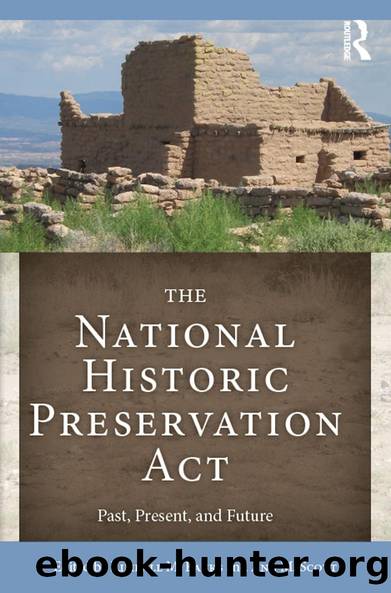The National Historic Preservation Act by Kimball M. Banks Ann M. Scott

Author:Kimball M. Banks, Ann M. Scott [Kimball M. Banks, Ann M. Scott]
Language: eng
Format: epub
ISBN: 9781629582955
Barnesnoble:
Publisher: Taylor & Francis
Published: 2016-04-13T00:00:00+00:00
SIGNIFICANT CHALLENGES AHEAD
Establishing the significance of sites is essential to how archaeologists operationalize the NHPA. Inventory and management surveys evaluate cultural resources against the qualities of integrity and the criteria necessary to be eligible for inclusion in the NRHP. When a site is in the path of development, evaluation of eligibility is a prerequisite to mitigation. âData recoveryâ is a synonym for full-scale excavation, and data is its primary product. The amassing of inventory information has led Arizona and New Mexico to invest in developing extensive databases: AZSITE and the New Mexico Cultural Resources Information System, respectively. The current curation crisis is the materialization of the data recovery effects of the NHPA.
The value of cultural heritage to the American public is a fundamental premise of NHPA. In current practice, data accumulation and documentation are acceptable end products. If the archaeologists who dig do not synthesize their findings and collections go into boxes and are rarely reexamined, this situation forces agencies and the public to question why we spend the money on archaeology and what differentiates archaeologists from other collectors interested in the past. In 1997, Rosenberg, who headed ADOTâs archaeological program for 17 years, asked if we are doing too much: âWhile we want creative investigations within the contract research arena, we need to be able to defend to our management why we are excavating yet another Hohokam villageâ (Rosenberg 2004: 31).
Lynne Sebastian (2009) has argued for a reevaluation of the role of significance assessments and a return to an emphasis on the research and public value of sites. But, for now, artifacts continue to enter repositories at an alarming rate. The Center for New Mexico Archaeology (part of the Museum of Indian Arts and Culture) recently opened a curation facility in cooperation with the Bureau of Land Management to manage federal, state, and tribal collections from New Mexico, but space needs in Arizona have reached the critical stage. There is minimal state support for curating archaeological collections, federal agencies do not pay their share, and the burden on the end users (land developers) keeps increasing. A new model is needed. Over 30 years ago, R. H. Thompson (1982) feared that we were not facing up to the âhard decisionsâ on significance and called for a triage system that would retain materials from certain contexts and in certain quantities and dispose of collections of materials with little or no context.
Download
This site does not store any files on its server. We only index and link to content provided by other sites. Please contact the content providers to delete copyright contents if any and email us, we'll remove relevant links or contents immediately.
Cecilia; Or, Memoirs of an Heiress — Volume 1 by Fanny Burney(31437)
Cecilia; Or, Memoirs of an Heiress — Volume 3 by Fanny Burney(31030)
Cecilia; Or, Memoirs of an Heiress — Volume 2 by Fanny Burney(30978)
The Great Music City by Andrea Baker(22608)
We're Going to Need More Wine by Gabrielle Union(18119)
Bombshells: Glamour Girls of a Lifetime by Sullivan Steve(13152)
Pimp by Iceberg Slim(12984)
All the Missing Girls by Megan Miranda(12825)
Fifty Shades Freed by E L James(12487)
Talking to Strangers by Malcolm Gladwell(11969)
Norse Mythology by Gaiman Neil(11952)
Crazy Rich Asians by Kevin Kwan(8404)
Mindhunter: Inside the FBI's Elite Serial Crime Unit by John E. Douglas & Mark Olshaker(7885)
The Lost Art of Listening by Michael P. Nichols(6523)
Enlightenment Now: The Case for Reason, Science, Humanism, and Progress by Steven Pinker(6442)
Bad Blood by John Carreyrou(5810)
The Four Agreements by Don Miguel Ruiz(5568)
Weapons of Math Destruction by Cathy O'Neil(5091)
We Need to Talk by Celeste Headlee(4915)
